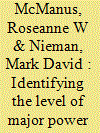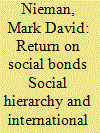| Srl | Item |
| 1 |
ID:
165999


|
|
|
|
|
| Summary/Abstract |
Major powers signal support for protégés in order to reassure them and deter harm against them. Yet, it is not always clear how to identify who a major power’s protégés are or the degree of support signaled. Major powers have a variety of complementary signals to choose among, including alliances, arms transfers, joint military exercises, and others. It can be difficult to weigh the importance of individual signals, especially since different major powers do not deploy each signal in the same way. We address this challenge using a Bayesian latent measurement model, which provides a theoretically coherent means of identifying the overall level of support signaled by a major power for a protégé. Our approach yields a cross-sectional time-series dataset, providing a continuous measure of the degree of support signaled by major powers for all minor powers from 1950 to 2012. Our model also provides insights regarding which signals of support are most informative when sent by each major power. We find considerable variation among major powers regarding which of their signals are most meaningful, but in general alliances and military exercises tend to be among the most important signals. In further applications using our latent measure, we also assess under which conditions major powers are likely to increase their signals of support for protégés, as well as predict whether a major power will intervene in conflicts involving its protégés.
|
|
|
|
|
|
|
|
|
|
|
|
|
|
|
|
| 2 |
ID:
147835


|
|
|
|
|
| Summary/Abstract |
This article takes a game-theoretic and latent variable approach to modeling the effect of international social hierarchies on conflict among states. I start with the premise that international states are social actors and are nested within informal social networks of friendly and conflictual relationships. Rather than lateral relationships among equals, networks among states tend to have a vertical or hierarchical structure. Although international hierarchical relationships may arise as a result of material power asymmetries, this article focuses on non-material asymmetries that stem from political legitimacy or policy innovation – a subject that has received less attention in scholarly research. I argue that, within these hierarchies, states adopt one of two roles – a dominant or a subordinate. Each resulting (dyadic) dominant–subordinate relationship is a social contract, in which the subordinate concedes some autonomy in exchange for the dominant’s protection. This social hierarchy affects the relationships among subordinates, as well as between a dominant and subordinates. The model predicts that a state’s degree of subordination reduces its probability of conflict initiation against other subordinates. Moreover, the decision to initiate conflict is influenced by the expectation that the dominant will intervene, which itself is affected by the target’s relative level of subordination to the dominant vis-à-vis the challenger. These predictions are supported by empirical analyses of the US hierarchy (1950–2000).
|
|
|
|
|
|
|
|
|
|
|
|
|
|
|
|